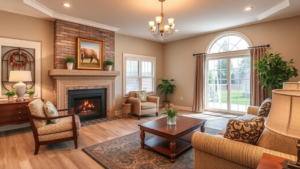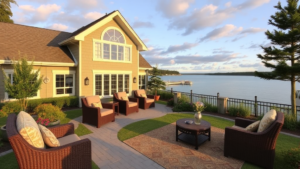Gray Blue And Green Living Room

Designing a Gray, Blue, and Green Living Room: A Harmonious Palette
Creating a living room decorated in gray, blue, and green is an excellent way to introduce a sense of calm and sophistication to your home. This color palette blends cool tones that can reflect personal style and foster a relaxing atmosphere. Let’s explore how you can effectively design a living room that captures the essence of these tranquil colors.
Choosing the Right Shades
When it comes to the gray, blue, and green living room, selecting the right shades is essential for achieving harmony. You can opt for various tones to create rich layers and depth in your space. Here are some suggestions:
- Gray: Light gray works well as a neutral base, while charcoal gray can add bold contrasts.
- Blue: Soft pastels like sky blue can provide a serene vibe, while deeper navy can inject elegance.
- Green: Consider muted shades like sage green for a fresher look or emerald green for a touch of luxury.
Textures
Textures play a crucial role in enhancing the visual appeal of your living room. Mixing textures can add interest to your design. Here’s how to incorporate them:
- Fabrics: Choose soft textiles like velvet cushions in blue and green and pair them with gray wool throws.
- Rugs: Use a textured area rug that combines all three colors, grounding the room while providing warmth.
- Wall Treatments: Consider textured wallpaper in a light gray, or paint an accent wall in a deeper blue for a striking look.
Furniture Selection
Your choice of furniture will significantly impact your living room’s aesthetics. Here are some tips:
- Neutral Gray Sofa: A sleek gray sofa serves as an excellent focal point. It can seamlessly connect the blue and green accents.
- Pair With Accent Chairs: Introduce chairs in complementary colors such as a vibrant green or rich navy to add personality.
- Coffee Tables: Opt for wooden tables that offer a natural contrast to your color palette.
Accessorizing Thoughtfully
Accessories are the finishing touches that can unify your design. Here are some accessories to consider:
- Artwork: Hang pieces that contain shades of blue and green to tie everything together.
- Plants: Incorporate plants or greenery to bring life into your living room.
- Cushions and Throws: Use throw pillows and blankets in various patterns that complement your colors.
Lighting Your Space
Proper lighting can elevate your living room’s ambiance significantly. Here are effective ways to light your gray, blue, and green living room:
- Natural Light: Maximize natural light with sheer curtains that allow sunlight to filter in.
- Layered Lighting: Use a mix of ambient, task, and accent lighting, such as floor lamps in muted tones.
- Statement Fixtures: Consider a chandelier with glass elements that reflect your palette’s colors.
Layout Ideas
The layout of your living room can affect how the different colors interact. Here are layout tips to maximize flow:
- Open Spaces: If you have an open-concept area, keep furniture arrangements fluid on the transitions between spaces.
- Focal Points: Place seating arrangements around a fireplace or entertainment center to create intimacy.
- Define Zones: Use rugs to delineate different areas for relaxation and conversation.
The best way to gather inspiration is by browsing through various design resources. Websites such as Houzz or Pinterest are excellent for discovering creative ideas. Remember, your living room is a reflection of your style and personality, so infuse it with elements that resonate with you.
By thoughtfully approaching your design with gray, blue, and green tones, you’re set to create a harmonious sanctuary. Embrace the soothing quality these colors provide and enjoy the beauty in your well-designed living space.
Furniture Choices to Enhance Gray, Blue, and Green Spaces
The Psychology of Color in Your Living Room
Accessorizing Your Living Room with Gray, Blue, and Green Elements
Creating a stunning living room that features gray, blue, and green elements can transform your space into a serene yet stylish retreat. These three colors blend beautifully, offering a sophisticated palette that balances calmness and vibrancy. When accessorizing your living room, think about how these colors can come together through various elements.
Choosing the Right Shades
When working with gray, blue, and green, the first step is choosing the right shades. Here are some color combinations to consider:
- Light Gray: A soft neutral that provides a backdrop for brighter colors.
- Sky Blue: Evokes the feeling of openness and freshness.
- Muted Green: Adds a touch of nature and tranquility.
These combinations can help you achieve a harmonious look. You can opt for lighter tones to make the room feel airy, or darker shades for a more dramatic effect.
Textures to Enhance Your Space
Various textures adds depth to your room. Consider these options:
- Soft Fabrics: Use plush pillows and throws in shades of gray, blue, and green. Fabrics such as velvet or cotton can create a cozy feel.
- Natural Elements: Bringing in wooden furniture or rattan accessories can give an organic touch to the color palette.
- Metal Accents: Silver or brass fixtures and décor can complement the colors wonderfully.
Mixing textures creates visual interest and makes your living room more inviting.
Artwork and Decorative Pieces
Art is a powerful way to infuse personality into your living space. Look for artwork that features gray, blue, and green:
- Paintings: Opt for abstract pieces that blend these colors, creating a focal point in the room.
- Prints and Posters: Vintage travel posters or landscape prints featuring these colors can resonate well.
- Sculptures: Consider decorative sculptures in glass or pottery that exhibit shades of your chosen color palette.
You can also incorporate framed family photos to personalize the décor. Use mats or frames in gray or blue tones to keep the look cohesive.
Furniture Choices
When selecting furniture, aim for pieces that echo the gray, blue, and green theme:
- Sofas and Chairs: A light gray sofa can serve as a versatile foundation. Add blue and green accent chairs or cushions for contrast.
- Coffee Tables: Choose tables in natural wood or with painted finishes that incorporate your color scheme.
- Rugs: A patterned area rug that includes all three colors can tie the space together.
Plants and Accessories
Bringing in greenery can enhance the living room’s atmosphere.
| Plant Type | Benefits |
|---|---|
| Fiddle Leaf Fig | Adds a touch of modern elegance. |
| Snake Plant | Great air purifier and easy to maintain. |
| Pothos | Versatile and thrives in different light conditions. |
In addition, consider decorative accessories such as vases, candles, or books in those shades to pull the look together. These small items can add color without overwhelming the space.
Creating a Cohesive Look
To create a cohesive appearance in your gray, blue, and green living room, remember the principle of balance. Here are some tips:
- Color Proportion: Use a 60-30-10 rule for color placement. Use 60% dominant color, 30% secondary color, and 10% accent color.
- Layering: Layer different elements like rugs, cushions, and throws to create a multi-dimensional look.
- Consistency: Ensure that the shades you choose resonate with each other for a unified appearance.
Accessorizing your living room with gray, blue, and green elements can create a stunning, functional space. You can explore various styles and accessories to find what best suits your taste.
If you want more inspiring ideas, check out House Beautiful and The Spruce for additional tips and tricks on home décor.
Tips for Maximizing Natural Light in a Gray, Blue, and Green Living Room
When designing a living room in shades of gray, blue, and green, it’s important to maximize natural light. This enhances the colors and creates a welcoming atmosphere. Here are some effective tips to help you harness natural light in your beautifully styled space.
Select the Right Color Scheme
The colors you choose can significantly affect how light is perceived in your room. Shades of gray, blue, and green can either absorb or reflect light, so it’s essential to select the right tones. For instance, lighter shades of these colors can amplify natural light. Consider using soft pastel blues, muted greens, or light grays. These hues not only brighten your space but also maintain a serene and calm ambiance.
Choose Light-Colored Furniture
Opt for furniture pieces in light colors or natural materials. Upholstered items in white or light beige will reflect light, making your living room feel airy and open. For wooden furniture, consider lighter woods like oak or birch. This choice complements your color scheme while promoting a spacious feeling.
Maximize Window Space
Your windows are the primary source of natural light. Ensure they are unobstructed. Use sheer or light-filtering curtains that allow sunlight to stream into your room. If you prefer blinds, select ones that can be fully raised or tilted to manage light effectively without blocking it entirely.
<table>
<tr>
<th>Type of Window Treatment</th>
<th>Light Control</th>
</tr>
<tr>
<td>Sheer Curtains</td>
<td>Gracious light diffusion</td>
</tr>
<tr>
<td>Light-Filtering Shades</td>
<td>Soft illumination</td>
</tr>
<tr>
<td>Wood Blinds</td>
<td>Adjustable light control</td>
</tr>
</table>Incorporate Mirrors
Mirrors are your best allies in maximizing natural light. By placing mirrors across from windows, you can bounce light throughout the room. Choose reflective surfaces that complement your color palette. A large decorative mirror can serve as both a statement piece and a practical light-enhancing tool.
Utilize Light-Reflective Surfaces
Furniture finishes play a crucial role in how light behaves in your room. Choose items with glossy or satin finishes rather than matte ones. This will increase reflectivity and distribute light better. Glass coffee tables or shiny metal accents can also enhance this effect.
Add Plants Strategically
Plants bring life into your space while helping to filter air. However, it’s crucial to place them where they won’t block light. Choose tall plants for corners and low-profile varieties for windowsills. Opt for plants with lighter colors or variegated leaves that resonate with your gray, blue, and green color scheme.
Maintain a Clutter-Free Environment
A tidy environment allows light to travel unhindered. Keep your living room organized by minimizing clutter. Consider multifunctional furniture that offers storage, helping to keep the space neat.
Use Lighting Wisely
In addition to natural light, incorporating artificial lighting is key. Soft white LED lighting in warm tones will enhance the overall feel of the room. Consider placing lamps in dark corners or using wall sconces to brighten areas where natural light doesn’t reach. Dimmable options also offer flexibility depending on the time of day.
Opt for Floor Coverings that Reflect Light
When selecting rugs, go for lighter colors that complement your room’s color palette. Natural fibers like jute or sisal reflect light beautifully, making the space feel larger. Avoid dark rugs, as they can absorb light and create a gloomy atmosphere.
Regular Maintenance
Keep your windows clean to ensure maximum light entry. Dust and grime can block significant amounts of natural light. A simple wipe-down every few weeks can dramatically change how light fills your living room.
By focusing on these strategies, you can create an inviting and bright living room that showcases your gray, blue, and green color scheme beautifully. For further insights on home decorating and maximizing natural light, feel free to explore resources like HGTV or Better Homes & Gardens to enhance your creative ideas and implementation.
These tips in your gray, blue, and green living room can transform it into a light-filled oasis, enhancing both style and comfort. You deserve a space that feels as bright and inviting as it looks, so start making these changes today!
Conclusion
Creating a living room that harmonizes gray, blue, and green offers a unique blend of tranquility and sophistication. By thoughtfully designing a space that embraces this soothing palette, you can transform your home into a serene haven. When it comes to furniture choices, look for pieces that complement the palette, such as soft gray sofas with blue and green accents, ensuring a cohesive look throughout the room. Remember, well-chosen furniture not only enhances aesthetics but also supports comfort and functionality.
Understanding the psychology of color is vital when designing your living space. Gray promotes calmness, while blue evokes feelings of serenity. Green adds a touch of nature, encouraging relaxation and rejuvenation. Merging these colors thoughtfully can foster a peaceful atmosphere, making your living room a perfect retreat for you and your guests.
Accessorizing further enhances the theme by introducing decorative items that carry the same color story. Consider pillows, throws, rugs, and artwork that feature shades of gray, blue, and green to tie the room together. These elements can provide texture and a personal touch, making the space feel uniquely yours.
Maximizing natural light can breathe life into your gray, blue, and green living room. Use light curtains or blinds to allow ample sunlight to filter in, illuminating the colors and creating a bright, airy ambiance. Thoughtful lighting choices can highlight key design features, ensuring that the beauty of your living space shines through.
By implementing these strategies, your gray, blue, and green living room can become a perfect blend of style and comfort, inviting all who enter to relax and enjoy the harmonious environment you have crafted.


